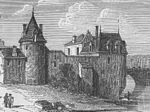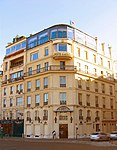Pierre and Marie Curie University
1971 establishments in France2018 disestablishments in FranceBuildings and structures in the 5th arrondissement of ParisDefunct universities in ParisEducational institutions disestablished in 2018 ... and 3 more
Educational institutions established in 1971Pierre and Marie Curie University peopleSorbonne University

Pierre and Marie Curie University (French: Université Pierre-et-Marie-Curie, UPMC), also known as Paris 6, was a public research university in Paris, France, from 1971 to 2017. The university was located on the Jussieu Campus in the Latin Quarter of the 5th arrondissement of Paris, France. UPMC merged with Paris-Sorbonne University into a new combined Sorbonne University. It was ranked as the best university in France in medicine and health sciences by Times Higher Education in 2018.
Excerpt from the Wikipedia article Pierre and Marie Curie University (License: CC BY-SA 3.0, Authors, Images).Pierre and Marie Curie University
Rue Jussieu, Paris 5th Arrondissement (Paris)
Geographical coordinates (GPS) Address Website Nearby Places Show on map
Geographical coordinates (GPS)
| Latitude | Longitude |
|---|---|
| N 48.847222 ° | E 2.356389 ° |
Address
Sorbonne Université - Faculté des Sciences et Ingénierie
Rue Jussieu
75005 Paris, 5th Arrondissement (Paris)
Ile-de-France, France
Open on Google Maps









